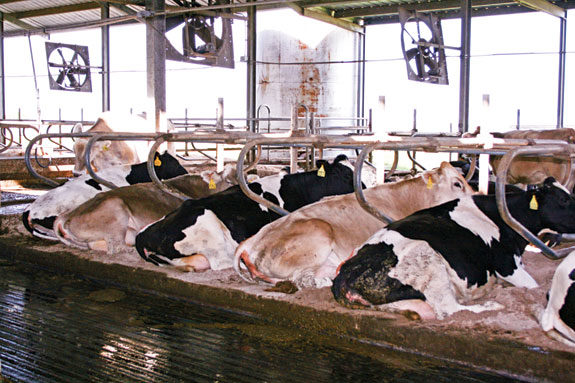Two main responses cows usually have to heat and humidity are to eat less feed and produce less milk. Another problem that often occurs with heat and humidity stress is an elevation in the somatic cell count of the herd. Below are some suggestions for reducing these summer stress responses of your cows. 1. Ask your nutritionist to check your rations for changes that will help maintain intake and milk production. Also check to be sure your cows are receiving adequate levels of vitamins A and E, and selenium.
These nutrients help promote a strong functioning immune system, which is needed to combat udder-invading bacteria and elevating SCC values.
2. Keep your cows as cool as possible so they don’t congregate in wet, mucky areas where they will surely end up with dirty udders.
Cooler cows usually have better functioning immune systems to combat udder-invading bacteria. Provide shade if the cows are on pasture or in an exercise lot. Install fans and water misters in your freestall barn alleys, parlor holding pen and return alleys to cool the cows. In certain areas of the country, cooling ponds are used to cool cows, but proper maintenance of the ponds is required to keep them from becoming contributors to a problem rather than a solution.
3. Keep the cows’ udders as clean as possible so the number of bacteria the teat ends are exposed to is minimized.
It is critical to keep cows and heifers out of mud. The cleanliness of the freestalls and alleys is very important for keeping udders clean, so the stall bedding material and the alleys may need to be cleaned at each milking (or perhaps more frequently) to minimize the soil that gets on the cows. Control flies so that they don’t spread bacteria.
4. If in a freestall, consider using a different stall bedding material that is less supportive of bacteria growth.
Since the teat ends are exposed to bacteria as the cows are resting in the stalls, try to use a bedding material that does not support the growth of bacteria. Sand is the preferred bedding material of many producers. If your waste-handling system cannot handle sand, then use kiln-dried sawdust/shavings. Avoid green sawdust. Pine products are preferred to hardwood products.
You may want to try adding a pH-altering product to the bedding material to slow the growth rate of bacteria in the bedding. Such products must be added every two to three days.
5. Proper udder preparation at milking time is critical to reducing/preventing the introduction of bacteria into the udder during milking.
The use of pre-dips and post dips, proper wiping and drying of the teats when cleaning them and minimizing the machine-on time are all very important in reducing the new cases of intra-mammary infections and in keeping the SCC value low. Barrier post-milking dips may be helpful in reducing environmental pathogen-caused infections.
6. Every milking parlor should have fans and sprinklers to give cows an opportunity to get cool at least twice a day.
Studies show that fans and sprinklers can pay for themselves in two to three years.
While producers may not be able to prevent completely the impact of summer’s heat and humidity, there are practices that can reduce the economic impact of heat stress on cows. Producers should talk with their consultants or county extension agents about what practices to consider implementing for their dairy. PD
— Excerpts from University of Arkansas Dairy Digest, Vol. 16, No. 4
Donald Pritchard
Extension Dairy
North Carolina State
Donald_Pritchard@ncsu.edu
PHOTO: While producers may not be able to prevent completely the impact of summer’s heat and humidity, there are practices that can reduce the economic impact of heat stress on cows. Photo by Natalie Kite.






